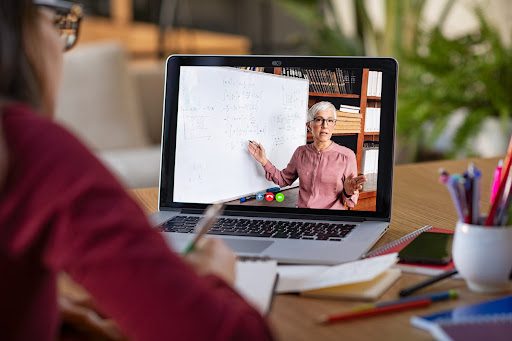 Distance learning has retained utility for students in remote areas, during inclement weather, and upon other unexpected events.
Distance learning has retained utility for students in remote areas, during inclement weather, and upon other unexpected events.
In some cases, teachers may teach virtual classes from home. Or they may do so from their classroom, possibly teaching both remote students and ones physically present.
The right distance learning classroom setup makes a difference. So, what equipment do teachers need to effectively teach their students and help remote students learn?
A Designated Space
This does not have to mean a full-blown home office, but having a good space set up to teach from is vital for those teaching from home. Make sure that your space is well-lit and free from clutter, and that you have a good physical background. (While virtual backgrounds are great, the flicker can be distracting for some students and if your connection is iffy, you may want to turn the virtual background off.) Consider making the space behind you look more like a classroom. Some teachers have gone as far as to put up a small whiteboard.
The Right Technology for Teaching from Home
The rapid pivot to remote learning left many teachers trying to teach at home using a tablet or even a phone.
Put together the electronics you need, which should include:
- A monitor large enough to let you see as many of your students at once as possible. A student who is not on the first page is less likely to be called upon.
- A mouse and keyboard you find ergonomically comfortable.
- A headset. While it is absolutely possible to do remote learning without one, it will help make sure your students can clearly hear what you have to say.
- A tripod. If you are using a phone or tablet to record, a tripod can allow you to place the device perfectly for your remote students.
School administrators should be ready to give teachers the advice and support they need to succeed in this area, and potentially to provide extra equipment.
Classroom Distance Learning Setup
With the rise of hybrid learning, it’s vital to have good audio and video equipment in the classroom. Instructors and school administrators should go for solutions designed for education. Some things to consider:
- A camera with a wide angle able to keep you and the whiteboard or chalkboard in frame. This allows you to teach freely without worrying about whether remote students can still see you.
- An interactive board that allows remote and virtual students to work together.
- A good flat screen TV or monitor which can be connected to the teacher’s laptop. You can then mirror the video conferencing software with the remote students to it. Position it facing the students who are present. This allows the students to see each other and get more of a feeling that they are interacting.
- A clear sound system that both picks up on the teacher’s words and allows all the students to hear each other. This is particularly important if lessons are going to be recorded.
Good Lighting
Whether at home or in the classroom, make sure that the lighting you use allows remote students to clearly see your face and doesn’t wash you out. Ideally, you want a light behind the monitor or device, but not shining right on your face. It can take a few attempts to get it right. If you aren’t able or comfortable asking your students to check your efforts, get a coworker or a trusted parent to log in and take a look.
The Right Chair
In a physical classroom, you stand and move around a lot. When teaching entirely virtually, you don’t. This can result in too much sitting and is even worse if you don’t have a comfortable chair.
Make sure that your chair is the right height so that your feet are firmly on the ground, that the back supports your back and that your keyboard is the right height. Some people who sit all day swear by gamer chairs. They are designed to be sat in for long periods of time without being so comfortable you start to drift off.
Conclusion
Hybrid learning is likely to be an integral part of the future. Also, with many districts replacing snow days with virtual learning days, teachers will need to continue to have the equipment at home to teach virtually. Teachers and school administrators need to make sure that classrooms are set up to allow for remote learning, and good audio and video equipment is key to this. At Moffitt Technology, we work closely with schools and other institutions to provide A/V solutions that work. Get in touch with us to learn more.

